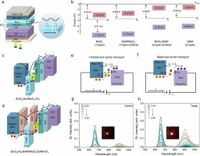Researchers have made significant strides in enhancing the efficiency of perovskite/organic tandem solar cells (TSCs), addressing critical performance limitations that have hindered their progress. By investigating the underlying mechanisms of carrier transport within these solar cells, they discovered that inadequate hole transport in the organic subcell was a primary limiting factor. To counter this, a novel hole transport self-assembled monolayer (SAM) anchored to molybdenum trioxide (MoO3) was implemented, converting the n-type MoO3 into a p-type surface, which significantly improved overall device performance.
The modified structure, termed SAM/MoO3/SAM sandwich configuration, facilitated enhanced hole extraction and effectively suppressed non-radiative recombination at the interconnection layer (ICL). This innovative approach led to a notable power conversion efficiency (PCE) of 26.05% and an impressive open-circuit voltage (VOC) of 2.21 V, verified by independent testing at a certified level of 2.216 V. Such efficiency represents a major milestone in the quest for high-performance TSCs, especially as the technology shows promise for maintaining operational stability over extended periods.
The structural composition of the new tandem device involves a top perovskite subcell using a mixed-halide perovskite architecture with a bandgap of approximately 1.85 eV, paired with a narrow-bandgap organic subcell utilizing PM6:BTP-eC9:L8-BO as the active layer, which possesses a bandgap of 1.37 eV. The overall device configuration is ITO/SAM/perovskite/C60/SnO2/Au/MoO3/organic active layer/PNDIT-F3N/Ag, effectively creating a well-integrated and highly functional photovoltaic structure.
The researchers meticulously crafted this tandem cell using a p-i-n configuration to incorporate each layer's characteristics. The experimental processes began with preparing the wide-bandgap perovskites, where the precursor solution was dissolved and aged to ensure optimal performance characteristics. Subsequent layers were integrated using precise spin-coating techniques and thermal deposition to ensure uniform layer thickness and functionality.
While previously observed TSCs have achieved efficiencies above 25%, findings indicated that optical and carrier recombination losses historically held back further advancements, especially within the ICL. Typically, the ICL serves as the vital junction wherein electrical and optical properties overlap, and its optimization is key to improving the performance metrics of solar cells. Researchers contend that balancing carrier transport through innovative surface modification techniques is critical.
The introduction of the SAM layer is a key innovation, significantly altering the energy level alignment within MoO3, thus facilitating smoother carrier flow from the organic active layer. The changes included transitioning the energy levels indicative of an n-type MoO3 to a favorable p-type configuration, evidenced by monitoring shifts in electronic properties through techniques such as X-ray photoelectron spectroscopy (XPS) and density functional theory (DFT).
The overall electrical characteristics of the device were meticulously quantified, with measurements indicating a notable decrease in series resistance down to about 4 ohms, a significant improvement over traditional MoO3 configurations, which exhibited resistance around 12 ohms. These changes corroborated the enhanced capability for carrier extraction and established seamless recombination pathways across the ICL.
The team also observed significant reductions in dark current density, indicating lower non-radiative recombination for the new structures compared to control devices. The target devices recorded dark currents two orders of magnitude lower than their predecessors, showcasing improved junction quality and cell performance.
With a measured TPV decay lifetime of 12.9 microseconds in the improved devices, the reduction of non-radiative recombination was further confirmed. The overall findings culminated in PCEs of impressive values: devices employing modified MoO3 configurations yielded efficiencies nearing 24.29% to 26.05%, while showcasing operational stability with some configurations maintaining over 84% of performance after 650 hours under real-world conditions.
These advancements position perovskite/organic TSCs on a promising trajectory toward more robust performances in practical applications, likely paving the way for further research and development in the renewable energy sector. The researchers' strategic implementation of SAM-modified transport layers offers a highly effective route to enhance efficiency and stability, marking an important step in advancing solar energy technology to meet global energy demands.




